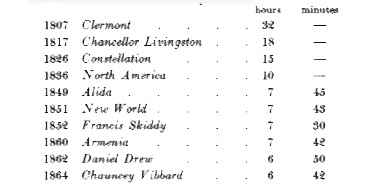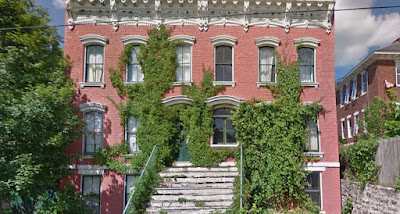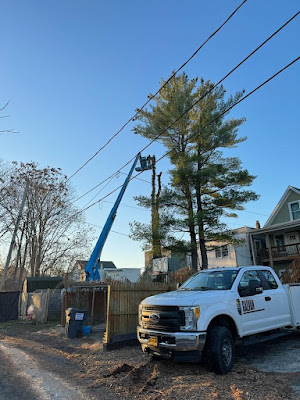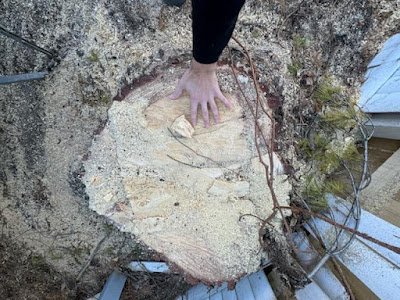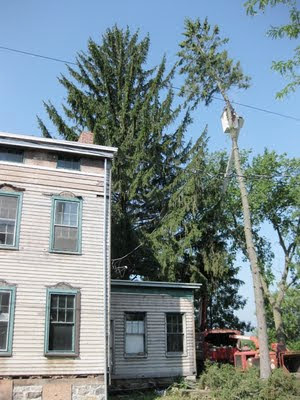Sunday, December 31, 2023
Friday, December 29, 2023
More About Hudson 150 Years Ago
There is one more item from the Hudson Weekly Star that merits sharing. It is this one, which reports on the whereabouts of passenger steamboats during the winter months of 1874.
The article speaks of the day line from Brooklyn to Troy, which would leave Brooklyn at 7:30 a.m. and 23rd Street in Manhattan at 8:00 a.m. and, "making the usual landings," would arrive in Albany and Troy "in time to connect with the afternoon trains for Saratoga, Lake George, Niagara Falls, &c." It is not indicated when the trains departed, but this chart, found in the book Old Steamboat Days of the Hudson River: Tales and Reminiscences of the Stirring Times that Followed the Introduction of Steam Navigation by David Lear Buckman (1907), indicates that by 1862 and 1864 there were steamboats making the trip from New York to Albany in under seven hours.
Thursday, December 28, 2023
More News from 150 Years Ago
A meme that appeared this morning on Facebook characterizes the period between Christmas and New Year's Day in this way:
An item that appeared in the Hudson Weekly Star on January 1, 1874, suggests that things were a bit different in Hudson 150 years ago. According to this report, in this period between holidays, hundreds of Hudsonians showed up to hear a temperance lecture.
The Franklin Library Association was founded in Hudson in 1837. Its library room was originally on Union Street near the current site of Christ Church Episcopal. When they left City Hall in 1874, they relocated to a room in the building at 343 Warren Street.
In his History of Columbia County, published in 1878, Captain Franklin Ellis reports this about the Franklin Library Association: "The system of public lectures, given under the auspices of the association, was inaugurated in 1838, and was regularly continued for many years, but has recently been discontinued, on account of the extravagant demands of lecturers and the decline of public interest in them."
The Franklin Library Association brought popular lecturers of the day to Hudson, among them Horace Mann, Henry Ward Beecher, and Bret Harte. John B. Gough may not be familiar to us in the 21st century, but in his day he was a very sought-after speaker. His popularity as a lecturer reportedly rivaled that of Ralph Waldo Emerson and Henry Ward Beecher. Gough spoke at least twice in Hudson as a Franklin Library Association lecturer, and he may have been one of the lecturers whose "extravagant demands" brought an end to the program. According to the website TeachUSHistory.org, "Gough turned temperance reform into a lucrative profession." The following is quoted from that source:
In 1842, John B. Gough took the pledge in Worchester, Massachusetts, and began a career of lecturing against the evils of drink. He frequently drew upon his own experiences. One contemporary called him "the poet of the D.T.s." Over the more than forty years he campaigned against drinking, Gough gave upwards of 9,600 lectures to more than nine million people in America, Canada, and Great Britain. When he died in 1886, the New York Times wrote that he "was probably better known in this country and in Great Britain than any other public speaker." He achieved such renown because of his success in converting drinkers. Hundreds of thousands took the pledge at the conclusion of one of his speeches. The parallel with the call from the revivalist to the converted to step forward and publicly renounce their sins is apparent.
Despite his celebrity and success as a temperance crusader, Gough fell off the wagon a few times. The most notorious incident occurred in New York City in 1845, just three years after he had taken the pledge. Stopping in New York on his way to Albany, Gough disappeared from his hotel for an entire week. His friends made efforts to find him, posting placards around the city with a description of him, suggesting that he might be the victim of an accident or foul play. A tip about his whereabouts was received "in a mysterious way" at the National Police Gazette, a newspaper known for sensation mongering. One of the owners of the Gazette followed up on the mysterious tip and found Gough in a brothel, in a part of the city known for crime and debauchery, "in a very intoxicated state." The story was published in the Gazette and picked up by newspapers all over the country. Gough maintained he had been tricked into drinking by someone named Jonathan Williams, or Williamson, who offered him a drink of raspberry soda and, when Gough unwittingly accepted the laced libation, "looked into my face with a devilish expression of exultation which I never shall forget." The entire account of the incident can be found here.
COPYRIGHT 2023 CAROLE OSTERINK
Wednesday, December 27, 2023
News from 150 Years Ago
Over the years, Gossips has shared information about renowned 19th-century landscape painter Frederic Edwin Church, who created and lived in the Persian-inspired "fortress" known as Olana, and his interactions with the city of Hudson. He bought his art supplies from a shop on Warren Street and provisions from a grocer on South Third. He and his family worshipped at the First Presbyterian Church, and he was great friends with George C. Yeisley, the church's minister. An item discovered in the Hudson Weekly Star for January 1, 1874, reveals another way Church was present in the lives of Hudsonians. It seems whenever he finished a painting, during the years he lived at Olana, it was reported in the local newspaper.
Frederic Edwin Church, Syria by the Sea, 1873, oil on canvas.
Detroit Institute of Arts, Gift of Mrs. James F. Joy, 10.11.
The painting is now in the collection of the Detroit Institute of Arts. It was given to the museum in 1910 by James F. Joy's widow.
COPYRIGHT 2023 CAROLE OSTERINK
Tuesday, December 26, 2023
Will There Be New Faces in the New Year?
One of the responsibilities of being the mayor of Hudson is to make appointments to various regulatory and governing boards: the Planning Board, the Zoning Board of Appeals, the Historic Preservation Commission, and the Hudson Housing Authority Board of Commissioners. Mayor Kamal Johnson seems to be falling behind in making appointments, and, as 2023 draws to a close, Gossips reviews the situation.
- The Planning Board has been one member short for quite a while now. At the end of 2023, the board will be three members short. John Cody's term ends on December 31, 2023, as does the term of Ben Forman, who was appointed this summer to finish out the term of Gene Shetsky, who resigned after accepting the job of cemetery clerk.
- The Zoning Board of Appeals has its requisite seven members, but Myron Polenberg's term expired at the end of 2022, and he has been serving for the past year without having been reappointed. Abbie Lazare's term expires on December 31, 2023. It is not known if she will be reappointed, or if she, like Polenberg, will continue to serve without being reappointed.
- The Historic Preservation Commission, which takes a fairly active role in making recommendations to the mayor for new members, currently has its requisite seven members, but, as is the case with the ZBA, one of its members continues to serve without having been reappointed. Hugh Biber's term on the HPC expired at the end of July 2023, and there is no indication that he has been reappointed.
- The Hudson Housing Authority Board of Commissioners is comprised of seven members--two resident members who are elected by HHA tenants and five members who are appointed by the mayor. For at least a year, there have only been four non-tenant members of the board: Revonda Smith, Claire Cousin, Rebecca Wolff, and Nick Zachos. Rebecca Borrer, who was appointed by Johnson in 2022, hasn't attended a meeting for at least a year.
COPYRIGHT 2023 CAROLE OSTERINK
Start Filling Your Calendar for January
On
Thursday, January 25, from 6:00 to 7:30 p.m., the
Hudson Area Library, in collaboration with the Jacob Leisler Institute for the
Study of Early New York History, presents "Making Sense of Early Currencies in North America," a talk by Simon Middleton. The event will be held
virtually on Zoom. To register, visit the Hudson Area Library History Room website.
Simon Middleton earned his Ph.D. from the City University of New York Graduate Center in 1998. He taught at the University of East Anglia and the University of Sheffield, before coming to William and Mary in 2018, where he is currently Associate Professor of History. He has published From Privileges to Rights: Work and Politics in Colonial New York City (Philadelphia, 2005), as well as articles in William and Mary Quarterly, Journal of Early American Studies, and American Journal of Legal History. He is currently completing a study of the introduction of paper money to the 18th-century middle colonies, New York and Pennsylvania.
The Jacob Leisler Library Lectures are made possible partially through the generous support of the Van Dyke Family Foundation and the Hudson River Bank and Trust Foundation.
Meetings and Events in the Week Ahead
The one city meeting scheduled for this week, a meeting of the Common Council ad hoc Parking Study Committee, has been canceled, leaving the last days of 2023 meeting free. Things don't start up again until a week from today, January 2, 2024.
Friday, December 22, 2023
Last Market Until February
Tomorrow is the final Saturday for the Holiday Market and your last chance to stock up on things before the Hudson Farmers' Market takes a holiday for the month of January.
A Deadline Looms
According to reports, there are eighty-five bills on Governor Kathy Hochul's desk, waiting to be signed or vetoed. The governor has until Sunday to do so. Among them is the LLC Transparency Act, which would create a public database listing the names of those who benefit from an LLC (limited liability corporation).
The Transparency Act is of particular interest at the moment because the building in the Bronx that suffered a partial collapse last week was owned by an LLC. CBS New York published this report a few days ago: "Bill awaiting Gov. Kathy Hochul's signature would make it easier to find out who owns a building in New York State." According to information available at Reinvent Albany, 37 percent of the buildings in Manhattan are owned by LLCs. (I could find no similar information for all of New York City.)
 |
| Photo: Gothamist |
Curious to know the impact of the proposed legislation on our little city, I did a quick survey of the assessment rolls and found that, of 2,045 taxable properties in Hudson, 245 of them--about 21 percent--are owned by LLCs. Would the law help our location code enforcement office do its work? I put the question to our code enforcement officer, Craig Haigh.
According to Haigh, when the code enforcement office receives notification of a transfer of ownership, and the new owner is an LLC, they do an investigation to identify an actual person associated with the LLC. Sometimes the notification incudes the name of a person associated with the LLC, but often there is only a phone number or nothing beyond the name of the LLC and an address. If there is a phone number, code enforcement will call the number to learn the name of a person. If there is no phone number, code enforcement will send a letter to the address given or seek more information from the attorney representing the LLC when the sale closed. Haigh acknowledged that, although he feels his office has the information it needs for about 90 percent of the buildings in Hudson owned by LLCs, the public database that would be created by the LLC Transparency Act would be helpful.
Also on Hochul's desk awaiting her signature or veto is the even-year elections bill, which would consolidate town- and county-level elections to even-number years, so they happen in the same year as presidential and congressional elections. Supporters of the bill argue it will boost voter turnout in local elections. In July, the Columbia County Board of Supervisors voted 13 to 10 in favor of a resolution calling for a veto of the legislation. The reasons for opposing the legislation stated in the resolution are explained is this article from the Register-Star: "Supervisors call for veto of even-year law." The law would not affect the scheduling of elections in cities.
COPYRIGHT 2023 CAROLE OSTERINK
Updates: Governor Kathy Hochul signed the LLC Transparency Act but negotiated a legislative amendment that, as Gothamist explains, will make the database that identifies the names of owners of LLCs available only for law-enforcement purposes.
Hochul also signed the bill that will move county- and town-level elections to even-number years.
Thursday, December 21, 2023
New Murals in Hudson Schools
The Hudson City School District announced yesterday the completion of two mural projects, one at Hudson Junior High School and the other at Hudson Senior High School.
The following is quoted from the press release issued by HCSD making the announcement:
Led by talented muralist and teaching artist Joe Pimentel, more than sixty students and staff members cohesively and beautifully brought inspiring murals to life in both buildings. Each mural contains quotes designed to empower students and staff every day. Both murals were completed on December 15, four days of work after several months of planning. . . .
Pimentel is known for his detailed murals at parks and school districts throughout New York State. He said it was fulfilling to see students’ joy following their hard work.
“Every school has a different setting and feel to it, and this one was very special,” Pimentel said. “After seeing the first day, so many more students signed up to participate. Just from their comments to me, it meant a lot to them.”. . .
The Junior High School’s mural is highlighted by an emerging Bluehawk with interpretations of diversity, respect, and unity under the theme of “Rise Above” by Junior High School students. Just above the Bluehawk is Dr. Mae Jemison’s quote, “Never be limited by other people’s limited imaginations.”
At the Senior High School, peace, love, and kindness are prevalent with a soaring Bluehawk and Malcolm X’s quote, “Light creates understanding, understanding creates love, love creates patience, and patience creates unity.”
Pimentel’s other artwork can be found on his social media channels, @JoePimentelArt, and on his website at joepimentelart.com.
Wednesday, December 20, 2023
Previewing the New Year
Yesterday, the Common Council held its last meeting of 2023. Five of the ten current councilmembers will not be returning in the new year: Art Frick (First Ward), Amber Harris and Ryan Wallace (Third Ward), and Theo Anthony and Malachi Walker (Fourth Ward).
New to the Common Council or returning after an absence of a term or two are:
- Gary Purnhagen, representing the First Ward
- Jennifer Belton and Rich Volo, representing the Fourth Ward
COPYRIGHT 2023 CAROLE OSTERINK
Monday, December 18, 2023
Plans for Charles Williams Park
At the informal Common Council meeting last week, Gail Wittwer-Laird of Starr Whitehouse, the same landscape architects who designed the new entrance to Promenade, are working with FOPS (Friends of the Public Square) on refurbishing Seventh Street Park, and helped Historic Hudson with its proposal for Bronson Park, presented the new plans for Charles Williams Park.
- Splash pad
- Outdoor fitness
- Basketball court and pickle ball court
- Play area (with new equipment for ages 2 to 5 and 5 to 12)
- Existing pavilion
- Nature play
- Public restrooms
- Rain garden
- Parking area
- Walking loop
Unfortunately, not all the improvements proposed for the park can be realized with the current budget for the park, which is $280,000. According to Wittwer-Laird, what can be achieved with the money currently available are the following elements of the overall plan:
- Site prep
- Earthwork and drainage improvements. utility connections for future restroom and splash pad
- Walking loop (paved)
- New basketball court (color seal coat and 12-foot fence)
- Expanded nature play
- Parking area with ADA stalls and wooden barrier
- Landscape plantings (canopy trees and rain garden)
More information about possibilities and options can be found on page 36 of the presentation.
COPYRIGHT 2023 CAROLE OSTERINK
Sunday, December 17, 2023
Meetings and Events in the Week Ahead
As we move toward the shortest day of the year, here's what is happening.
- On Monday, December 18, the Hudson Housing Authority (HHA) Board of Commissioners holds its monthly meeting at 6:00 p.m. Word is that the public will not have an opportunity to see the plans for the redevelopment and expansion of HHA properties until it has been determined if the project is financially viable. Still, some information about the project may be revealed. The meeting is a hybrid, taking place in person in the Community Room at Bliss Towers, 41 North Second Street, and on Zoom. Click here to join the meeting remotely.
- On Tuesday, December 19, the Common Council holds its regular monthly meeting. Although at this point it does not yet appear on the agenda for the meeting, it is expected that the tree ordinance proposed by the Conservation Advisory Council will be presented to the full Council at this meeting. In anticipation of this, former long-term Hudson mayor Richard Scalera posted this alert to the "Unfiltered Hudson" Facebook group.
The meeting is a hybrid, taking place in person at the Central Fire Station, 77 North Seventh Street, and on Zoom. Click here to join the meeting remotely.
- On Wednesday, December 20, the Zoning Board of Appeals (ZBA) meets at 6:00 p.m. The meeting is in person only at the Central Fire Station, 77 North Seventh Street. No agenda for the meeting has been published.
- On Thursday, December 21, it's the Winter Solstice, the beginning of three months of winter but also the occasion to celebrate the return, however gradual, of the light.
Pillars Restored, History Honored
In September 2022, Gossips reported on a plan, proposed by Ken Sheffer and Jeff Tsui, to restore the pillars at the entrance to the athletic fields of the historic Chancellor Robert R. Livingston Educational Center, now known as Montgomery C. Smith Elementary School: "Help for the Historic Athletic Field." At that time, the pillars were in sad disrepair.
Today, thanks to Sheffer and Tsui, the pillars have been restored to their original state. The pictures below show the pillars when they were newly completed in 1936 and as they are today, after being meticulously restored.
BRICKS MATTER AND HISTORIC PILLARS MATTER
In 2022, my husband Jeff Tsui and I presented to the Hudson Board of Education a plan to save the broken and damaged brick pillars that guard the iconic and historic recreation area of the Livingston/M.C. Smith Center that Dr. Laurie Cox designed circa 1929 to 1937 (he just kept on designing). The pillars were meant by Cox and Smith to guard the school and also to guard the students who were to enter the campus through them.
The ones most in danger in 2022 were the most iconic ones, nearest the tennis courts. We were called and told that consideration was being given to taking down the pillars. Numerous complaints had been lodged about their dangerous state. Jeff and I jumped into action and made our pitch, which was approved unanimously by the BOE. For that, we are grateful. As we said then, bricks matter. Bricks should be forever. And brick pillars matter even more on an officially declared historic landscape. We were all over it.
Both M.C. Smith and Laurie Cox saw the pillars and the heavy steel fence as key victories in defining the property. (It was raining money on that field for about seven years during the New Deal era.) On April 22, 1936, Cox made his final design pitch on the pillars and fence, and it was approved by Smith and the Hudson BOE that day, according to his diary. And then contracts flew.
In May of 1936 Cyclone Fence, as represented by J.C. Rogerson's of Hudson, was selected to build and install that heavy Bethlehem Steel fence. Cox personally designed the acorn finials for the larger fence posts.
Between June and August of 1936, Cox, Cyclone, and Rogerson's managed the installation of the brick pillars (Cary bricks) and fencing. By September 1, 1936, it was all done and standing proudly over the Livingston campus.
Then shoot forward to 2022, when the danger of losing those pillars became an almost reality. And so we turned to the best, Mike Budai ot Budai Restoration Masonry. He was on it and vowed to save the pillars one at a time. So, two down, nine to go. Mike did it all and even posed with Cox's Hudson WPA sign in from of the pillars (when I forced him to do it).
The next step is to bend the steel gates to open and close properly. That will be done in the spring. Promise. But Mike tells us the pillars are now stronger than they were in 1936. (I won't tell the Cox or Smith families.) And safer. Mike said many tennis players thanked him for making the gates safe and shiny again.
Thank you, Hudson, Hudson BOE, and all for your patience as this work went on. But now we know how to build a lasting memorial--use bricks, steel, and Mike Budai. You can't lose.
Mike and I reviewed the remaining nine pillars, and he will deal with the minor repairs and shining they need in the spring.
But as we said at the time, this is for the students, to welcome them back to the fields, to enjoy the outdoors and the sporting world we so enjoyed as kids, Safely and with historic pride.
Ken Sheffer
Sheffer's book, Hudson's Heart: The Story of Hudson, New York's "Greatest Deal from the New Deal," a small sampling of which Gossips was honored to share back in September, is coming soon. It tells the fascinating story of how, in the darkest days of the Great Depression, the showplace that was the Livingston Educational Center came to be in our little city.
Friday, December 15, 2023
The Fate of 501 Union Street
"Don't ask for permission. Ask for forgiveness." It would seem some variation of that advice is the modus operandi of the Galvan Foundation when it comes to the Historic Preservation Commission.
This morning, Charles Gottlieb, attorney for Galvan, attended the HPC meeting on Zoom to present an application for a certificate of appropriateness to apply limewash to 501 Union Street, which, as we all know, has already had limewash applied to it. It should be remembered that the certificate of appropriateness granted for the building specifically indicated: "Original patina of brick shall be maintained."
Also present at the meeting, on Zoom, was Kurt Hirschling from Jan Hird Pokomy Associates, the expert Galvan hired to advise them about correcting the illegal application of limewash. Hirschling confirmed what everyone already knew: trying to remove the limewash risked damaging the brick. His recommendation was to apply another two to three coats of a 20 percent solution of limewash (80 percent water to 20 percent hydrated lime). According to Hirschling, the north facade of the building now has two coats of a 3 percent solution, and the rest of the building has just one coat of 3 percent solution. Hirschling argued that doing a limewash treatment, which would cause the building to appear as if it had been painted white, would make it blend in better with the surrounding structures, which for the most part are painted wood. He also indicated that it would take three to five years for the limewash that had already been applied to erode away.
Barry said she didn't think the example provided was relevant because the house wasn't brick. Hirschling told her that it was in fact brick.
Since it was agreed all around that trying to remove the limewash would damage the brick, the HPC has two choices. They can deny a certificate of appropriateness and wait for the limewash that has already been applied to wear away. That process is expected to take three to five years, and in the meantime the limewash will be increasingly blotchy and mottled. Or they can allow more limewash to be applied and accept a building that will, now and forever, look like it has been painted white.
According to Hirschling, there are thousands of historic buildings that have been limewashed. HPC member Miranda Barry wanted to see pictures of some of those buildings. During the meeting, Hirschling was able to produce only this one, which shows an Arts and Crafts house that has been limewashed.
Throughout the discussion, Phil Forman, who chairs the HPC, came back to the question of why the directive, clearly stated in the certificate of appropriateness, had been ignored. The only answer he got from Gottlieb was that it was "simply a miscommunication."
Barry suggested that a public hearing on the limewash was in order, adding, "We should have some examples of other buildings with limewash and show them to the public." It was decided that a public hearing would be held at the next meeting of the HPC, which is scheduled to take place on Friday, January 12.
Earlier in Friday's meeting, the HPC approved a certificate of appropriateness for 28-30 Allen Street, which contains the following condition:
This C of A does not authorize any painting of the exterior brick facade of the building. The original patina of the brick shall be maintained and any cleaning that is done shall be nonabrasive and not debride the finish.
Of course, in the case of this house (also a Galvan project), the paint was removed from the brick without a certificate of appropriateness from the HPC or even a building permit to do work on the exterior.
In discussing the project, Victoria Polidoro, legal counsel to the HPC, said the brick had been sandblasted, a statement that no one on the HPC seemed to react to with appropriate horror. Sandblasting is extremely harmful to old brick. Not only does it remove the patina of old brick, leading to a loss of architectural authenticity, it can cause irreversible damage to the porous nature of brick. In most cities with historic preservation ordinances, sandblasting is outlawed altogether. Curious to know if 28-30 Allen Street had in fact been sandblasted, I asked Walter Chatham, who was the architect for the project, how the paint had been removed. He provided the information that the paint had been removed with a hot water pressure washer.
Somehow, hot water pressure washer didn't sound significantly better to me than sandblasting, so I decided to consult the Secretary of the Interior's Standards for Rehabilitation and Guidelines for Rehabilitating Historic Buildings, this country's highest authority for historic preservation. The Secretary of the Interior's Standards has this to say about removing paint on masonry:
Recommended Retaining the original or early color and texture of masonry surfaces, including early signage whenever possible. Brick or stone surfaces may have been painted or whitewashed for practical and aesthetic reasons.
Not Recommended Removing paint from masonry surfaces indiscriminately. This may subject the building to damage and change its appearance.
The Guidelines for Rehabilitating Historic Buildings lists the following things as Not Recommended:
Applying high pressure water cleaning methods that will damage historic masonry and the mortar joints.
Removing paint that is firmly adhering to, and thus protecting, masonry surfaces.
Using methods of removing paint which are destructive to masonry, such as sandblasting, application of caustic solutions, or high pressure waterblasting.
Obviously, the paint on 28-30 Allen Street should not have been removed without thoughtful review by the HPC of the method proposed. Equally obvious is that the HPC needs to step up its game when it comes to the application and removal of paint--and limewash--on historic masonry buildings.
COPYRIGHT 2023 CAROLE OSTERINK
Thursday, December 14, 2023
Protections Coming Too Late for Some
People inside and outside city government have been talking about a tree ordinance to protect mature trees from needless destruction for close to twenty years. We may finally be getting to the point of actually having such an ordinance. At the informal Common Council meeting on Monday, Councilmember Margaret Morris (First Ward), who chairs the Legal Committee, reported that a draft of the tree ordinance would be ready for consideration by the full Council at its regular monthly meeting on Tuesday, December 19. Sadly, it will come too late for some trees in the 300 block of State Street.
In recent days, two large fir trees were cut down behind 340 State Street, a house owned by Hudson Collective Realty, a Galvan LLC.
Today Gossips received reports that the equipment used to take down the two trees at 340 State Street has been moved to the yard behind 336 State Street, another house owned by Hudson Collective Realty. It is likely this tree will be coming down next.
 |
| 123 Union Street |
 |
| 9 Union Street |
 |
| 356 Union Street |
A draft of the proposed tree ordinance, which may not be the final one, can be found here.
COPYRIGHT 2023 CAROLE OSTERINK
Subscribe to:
Comments (Atom)





